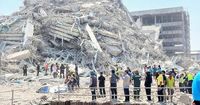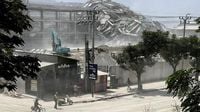A powerful earthquake struck Myanmar on March 28, 2025, registering a magnitude of 7.7, with tremors felt as far away as Bangkok, Thailand. The seismic activity triggered panic among residents and tourists, leading to evacuations and reports of structural damage in the Thai capital.
The earthquake's epicenter was located in Myanmar, approximately 10 kilometers deep, according to the U.S. Geological Survey and the German Geosciences Center GFZ. In Bangkok, the tremors were so intense that they caused buildings to sway and even collapse. Eyewitness accounts described a chaotic scene as sirens blared and thousands of people rushed out of hotels and residential buildings.
Julia, a resident of Bangkok who was on the 54th floor of a building in the Silom area during the quake, recounted her experience: "The building started to sway. When the tremors stopped, I managed to go down the stairs." Video footage she provided showed crumbling plaster and minor damage inside the building.
Another resident, Veronica, described the ground literally trembling beneath her feet as she fled into the street. "It was very frightening," she added, reflecting the tense atmosphere that enveloped the city following the earthquake.
As the dust settled, reports emerged of significant structural damage. At least seven buildings collapsed in Bangkok, with 43 workers reportedly trapped under the rubble. The authorities have begun search and rescue operations, though the number of casualties remains unknown.
In addition to Bangkok, tremors were felt across several regions, including India, Laos, and China, highlighting the earthquake's widespread impact. According to Khaosod, the situation in Bangkok prompted the temporary suspension of metro services, and local officials warned residents about the possibility of aftershocks.
Amidst the chaos, the Thai government mobilized emergency services, with ambulances and police actively patrolling the streets. Assel Abilkhamit, who lives in Bangkok with her family, reported that strong tremors occurred about an hour and a half prior to her account. She noted, "We felt a powerful horizontal shaking; cracks appeared in the walls of our residential complex, and plaster fell in the corridors. Currently, we are outside with other residents, waiting for updates from the authorities."
Despite the panic, Abilkhamit mentioned that the situation felt calm but alarming, as many awaited assessments of their buildings. "The fire department arrived quickly to evaluate the structures, and we are hoping for their verdict," she said.
Meanwhile, Kazakh citizens in Bangkok shared their experiences with local media. Tair, who arrived in the city from Pattaya, described the earthquake as less intense than its aftermath. "Public transportation is not working, and it’s hard to call a taxi. At first glance, the buildings don’t seem severely damaged," he stated, emphasizing that there was no widespread panic among the locals.
Timur, another Kazakh citizen in Pattaya, noted that the tremors were barely noticeable there. "In Pattaya, everything is fine; public transport and taxis are operating normally," he remarked, contrasting the situation in Bangkok.
As rescue efforts continue, the Russian embassy has been working to assess the situation regarding any Russian nationals who may have been affected by the earthquake. Reports indicate that there might be up to 2,000 Russian tourists currently in Bangkok, a popular destination for travelers from the Khanty-Mansi Autonomous Okrug during the winter months.
In the wake of this devastating earthquake, officials are urging residents to remain vigilant and prepared for potential aftershocks. The Thai authorities have mobilized emergency services to ensure the safety of residents and tourists alike. As the situation unfolds, many are left to grapple with the aftermath of a natural disaster that has shaken the region.
In Myanmar, the earthquake's impact was equally severe, with initial reports indicating significant damage and casualties. The country has been urged to assess the extent of the destruction and provide aid to affected areas. The tremors were felt just 12 minutes apart, with the second earthquake registering a magnitude of 6.4.
The events of March 28 serve as a stark reminder of the unpredictable nature of seismic activity in the region. While Bangkok is not typically known for its seismic activity, this earthquake has prompted discussions about preparedness and response strategies in urban areas that may not be accustomed to such events.
As recovery efforts begin, the focus will shift to ensuring the safety of residents and tourists, as well as assessing the structural integrity of buildings throughout Bangkok. With many still in shock from the experience, the community will need to come together to support one another in the days and weeks to come.









